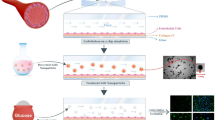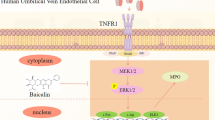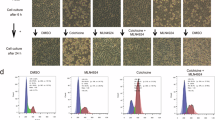Abstract
Aim:
To investigate the protective effects of preconditioning human umbilical vein endothelial cells (HUVECs) with Polygonum multiflorum stilbeneglycoside (PMS) under anoxia/reoxygenation (A/R), and the mechanism of protection.
Methods:
Prior to A/R, HUVECs were incubated with PMS (0.6×10−11, 1.2×10−11, or 2.4×10−11 mol/L) for 3 h. Cell injury was subsequently evaluated by measuring cell viability with an MTT assay and lactate dehydrogenase (LDH) release, whereas lipid peroxidation was assayed by measuring malondialdehyde (MDA) content. Antioxidant capacity was quantified by superoxide dismutase (SOD) and glutathione peroxidase (GSH-Px) activity. Nitric oxide (NO) production was determined by nitrite accumulation. Endothelial NO synthase (eNOS) and inducible NOS (iNOS) protein expression was detected by Western blotting. Guanylate cyclase activity and cyclic GMP (cGMP) activity were assessed by an enzyme immunoassay kit.
Results:
PMS incubation attenuated A/R-induced injury in a concentration-dependent manner, as evidenced by a decrease in LDH activity and an increase in cell viability. PMS exerted its protective effect by inhibiting the A/R-mediated elevation of MDA content, as well as by promoting the recovery of SOD and GSH-Px activities. Additionally, PMS incubation enhanced NO and cGMP formation by increasing iNOS expression and guanylate cyclase activity. The protective effects of PMS were markedly attenuated by NOS inhibitor L-NAME, soluble guanylate cyclase inhibitor ODQ or PKG inhibitor KT5823.
Conclusion:
PMS preincubation resulted in the enhancement of antioxidant activity and anti-lipid peroxidation. The NO/cGMP/cGMP-dependent protein kinase (PKG) signaling pathway was involved in the effect of PMS on HUVECs.
Similar content being viewed by others
Log in or create a free account to read this content
Gain free access to this article, as well as selected content from this journal and more on nature.com
or
References
Eltzschig HK, Collard CD . Vascular ischaemia and reperfusion injury. Br Med Bull 2004; 70: 71–86.
Lefer DJ, Scalia R, Campbell B, Nossuli T, Hayward R, Salamon M, et al. Peroxynitrite inhibits leukocyte-endothelial cell interactions and protects against ischemia–reperfusion injury in rats. J Clin Invest 1997; 99: 684–91.
Muller WA . Migration of leukocytes across endothelial junction: some concepts and controvercies. Microcirculation 2001; 8: 181–93.
Fisher M . Injuries to the vascular endothelium: vascular wall and endothelial dysfunction. Rev Neurol Dis 2008; 5: S4–11.
Grotti S, Gori T . Endothelium, ischemia and the good side of oxygen free radicals. Clin Hemorheol Microcirc 2008; 39: 197–203.
Li C, Jackson RM . Reactive species mechanisms of cellular hypoxia-reoxygenation injury. Am J Physiol 2002; 282: C227–41.
Csonka C, Szilvassy Z, Fulop F, Pali T, Blasig IE, Tosaki A, et al. Classic preconditioning decreases the harmful accumulation of nitric oxide during ischemia and reperfusion in rat hearts. Circulation 1999; 100: 2260–6.
Maejima Y, Adachi S, Ito H, Nobori K, Tamamori-Adachi M, Isobe M . Nitric oxide inhibits ischemia/reperfusion-induced myocardial apoptosis by modulating cyclin A-associated kinase activity. Cardiovasc Res 2003; 59: 308–20.
Chen HP, Liao ZP, Huang QR, He M . Sodium Ferulate attenuates anoxia/reoxygenation-induced calcium overload in neonatal rat cardiomyocytes by NO/cGMP/PKG pathway. Eur J Pharmacol 2009; 603: 86–92.
Sasaki N, Sato T, Ohler A, O'Rourke B, Marban E . Activation of mitochondrial ATP-dependent potassium channels by nitric oxide. Circulation 2000; 101: 439–45.
Buchwalow IB, Schulze W, Karczewski P, Kostic MM, Wallukat G, Morwinski R, et al. Inducible nitric oxide synthase in the myocard. Mol Cell Biochem 2001; 217: 73–82.
Vila-Petroff MG, Younes A, Egan J, Lakatta EG, Sollott SJ . Activation of distinct cAMP-dependent and cGMP-dependent pathways by nitric oxide in cardiac myocytes. Circ Res 1999; 84: 1020–31.
Burley DS, Ferdinandy P, Baxter GF . Cyclic GMP and protein kinase-G in myocardial ischaemia-reperfusion: opportunities and obstacles for survival signaling. Br J Pharmacol 2007; 152: 855–69.
Schulz R, Cohen MV, Behrends M, Downey JM, Heusch G . Signal transduction of ischemic preconditioning. Cardiovasc Res 2001; 52: 181–98.
Chan YC, Wang MF, Chang HC . Polygonum multiflorum extracts improve cognitive performance in senescence accelerated mice. Am J Chin Med 2003; 31: 171–9.
Xiao PG, Xing ST, Wang LW . Immunologrical aspects of Chinese medicinal plants as antiageing drugs. J Ethnopharmacol 1993; 38: 167–75.
Hong CY, Lo YC, Tan FC, Wei YH, Chen CF . Astrafalus membranaceus and Polygonum multiflourm protect rat heart mitochondria against lipid peroxidation. Am J Chin Med 1994; 22: 63–70.
Chen Y, Wang M, Rosen RT, Ho CT . 2,2-Diphenyl-1-picrylhydrazyl radical-scavenging active components from Polygonum multiflorum Thunb. J Agric Food Chem 1999; 47: 2226–8.
Zhang SH, Wang WQ, Wang JL . Protective effect of tetrahydroxystilbene glucoside on cardiotoxicity induced by doxorubicin in vitro and in vivo. Acta Pharmacol Sin 2009; 30: 1479–87.
Lv LS, Gu XH, Tang J, Ho CT . Antioxidant activity of stilbene glycoside from Polygonum multiflorum Thunb in vivo. Food Chem 2007; 104: 1678–81.
Yang PY, Almofti MR, Lu L, Kang H, Zhang J, Li TJ, et al. Reduction of atherosclerosis in cholesterol-fed rabbits and decrease of expressions of intracellular adhesion molecule-1 and vascular endothelial growth factor in foam cells by a water-soluble fraction of Polygonum multiflorum. J Pharmacol Sci 2005; 99: 294–300.
Rui T, Feng Q, Lei M, Peng T, Zhang J, Xu M, et al. Erythropoietin prevents the acute myocardial inflammatory response induced by ischemia/reperfusion via induction of AP-1. Cardiovasc Res 2005; 65: 719–27.
Jaffe EA, Nachman RL, Becker CG, Minick CR . Culture of human endothelial cells derived from umbilical vein: identification by morphologic and immunologic criteria. J Clin Invest 1973; 52: 2745–56.
Koyama T, Temma K, Akera T . Reperfusion-induced contracture develops with a decreasing [Ca2+]i in single heart cells. Am J Physiol 1991; 261: H1115–22.
Gomez LA, Alekseev AE, Aleksandrova LA, Brady PA, Terzic A . Use of the MTT assay in adult ventricular cardiomyocytes to assess viability: effects of adenosine and potassium on cellular survival. J Mol Cell Cardiol 1997; 29: 1255–66.
Niehaus WG Jr, Samuelsson B . Formation of malondialdehyde from phospholipid arachidonate during microsomal ipid peroxidation. Eur J Biochem 1968; 6: 126–30.
Donato H Jr, Biehl ER . The reaction of nitro-blue tetrazolium with d,l-L-tetrahydrofolate: The effect of pH, oxygen, formaldehyde and palladium (II). Chem Biol Interact 1982; 39: 31–43.
Zakowski JJ, Tappel AL . A semiautomated system for measurement of glutathione in the assay of glutathione peroxidase. Anal Biochem 1978; 89: 430–6.
Green LC, Wagner DA, Glogowski J, Skipper PL, Wishnok JS, Tannenbaum SR . Analysis of nitrate, nitrite, and 15N] nitrate in biological fluids. Anal Biochem 1982; 126: 131–8.
Binda MM, Molinas CR, Koninckx PR . Reactive oxygen species and adhesion formation: clinical implications in adhesion prevention. Hum Reprod 2003; 18: 2503–7.
Jones SP, Hoffmeyer MR, Sharp BR, Ho YS, Lefer DJ . Role of intracellular antioxidant enzymes after in vivo myocardial ischemia and reperfusion. Am J Physiol Heart Circ Physiol 2003; 284: H277–82.
Robin E, Guzy RD, Loor G, Iwase H, Waypa GB, Marks JD, et al. Oxidant stress during simulated ischemia primes cardiomyocytes for cell death during reperfusion. J Biol Chem 2007; 282: 19133–43.
Fariss MW, Chan CB, Patel M, Van Houten B, Orrenius S . Role of mitochondria in toxic oxidative stress. Mol Interv 2005; 5: 94–111.
Moens AL, Claeys MJ, Timmermans JP, Vrints CJ . Myocardial ischemia/reperfusion-injury, a clinical view on a complex pathophysiological process. Int J Cardiol 2005; 100: 179–90.
Lee SY, Andoh T, Murphy DL, Chiueh CC . 17beta-estradiol activates ICI 182,780-sensitive estrogen receptors and cyclic GMP-dependent thioredoxin expression for neuroprotection. FASEB J 2003; 17: 947–8.
Cuong DV, Kim N, Youm JB, Joo H, Warda M, Lee JW, et al. Nitric oxide-cGMP-protein kinase G signaling pathway induces anoxic preconditioning through activation of ATP-sensitive K+ channels in rat hearts. Am J Physiol Heart Circ Physiol 2006; 290: H1808–17.
Jang Y, Wang H, Xi J, Mueller RA, Norfleet EA, Xu Z . NO mobilizes intracellular Zn2+ via cGMP/PKG signaling pathway and prevents mitochondrial oxidant damage in cardiomyocytes. Cardiovasc Res 2007; 75: 426–33.
Andoh T, Chiueh CC, Chock PB . Cyclic GMP-dependent protein kinase regulates the expression of thioredoxin and thioredoxin peroxidase-1 during hormesis in response to oxidative stress-induced apoptosis. J Biol Chem 2003; 278: 885–90.
Acknowledgements
This study was supported by the National Natural Scientific Foundation of China (No 30760075) and the Natural Scientific Foundation of Jiangxi Province (No 2007GQY1110).
Author information
Authors and Affiliations
Corresponding authors
Rights and permissions
About this article
Cite this article
Liu, Lp., Liao, Zp., Yin, D. et al. The protective effects of Polygonum multiflorum stilbeneglycoside preconditioning in an ischemia/reperfusion model of HUVECs. Acta Pharmacol Sin 31, 405–412 (2010). https://doi.org/10.1038/aps.2010.7
Received:
Accepted:
Published:
Issue date:
DOI: https://doi.org/10.1038/aps.2010.7



